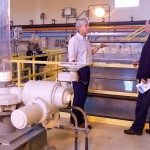 Michiganders are very aware the Great Lakes possess one-fifth of the world’s fresh water and that it is a very precious commodity. In a world with more than 7 billion people thirsty for clean water, it is predicted Michigan’s “liquid asset” will become more precious than oil as this century progresses.
Michiganders are very aware the Great Lakes possess one-fifth of the world’s fresh water and that it is a very precious commodity. In a world with more than 7 billion people thirsty for clean water, it is predicted Michigan’s “liquid asset” will become more precious than oil as this century progresses.
There is no question of the paramount importance for these bodies of water to remain as clean and pristine as possible. That is one of the reasons for the existence of the George W Kuhn Retention Treatment Basin Facility.
Originally built in 1972 for high volumes of combined storm and sewer water to be stored, screened and disinfected before discharged into the Clinton River and Lake St. Clair, the George W. Kuhn Retention Basin Facility was the very first water pollution control system. Following passage of the Clean Water Act of 1972 and with downstream communities clamoring for cleaner water entering the Clinton River and Lake St. Clair, 14 communities and Oakland County sought the best technological answer at that time to solve the overflow problem of combined sewer and sanitary water ending up in those bodies of water. The result is that this facility, with major upgrades completed in 2006, remains on the cutting edge for communities serious about protecting the environment, maintaining the health and welfare of their residents and businesses in which they serve when it comes to water quality.
Having had the opportunity to view the facility up close and personal, it is a technological and engineering marvel that is difficult to describe without having seen it first hand. It is a massive facility, most of which is underground and serves as both storage and diversion of incredible flowing amounts of water rushing into the facility from surrounding cities, towns and villages. Even a half-inch rain can push the facility into service since the rain is dumped into sewers and drains over a 28 square mile service area, all of which ends up at this facility.
The original facility was unable to meet more stringent environmental regulations of the 1990’s and planning for expansion followed thereafter. With exhaustive planning and design efforts, the expansion incorporated the original facility and enhanced its overall performance. Following expansion of the George W Kuhn Retention Treatment Basin Facility, it now has the latest engineering and controls technology to protect and improve water quality of the Clinton River and Lake St. Clair for the future needs of our areas’ business and residential communities.
While the former retention treatment basin had 62 million gallons (mg) of storage capacity for combined sewer overflows (cso), the present system can handle up to 124 mg of total storage volume. A new 2,000 foot long underground retaining wall located downstream controls smaller rainstorms and assists with hydraulic control of larger storms. The retention treatment basin also has one of the largest screening operations in all of North America. Sixteen screens are used for normal rain events with another four screens available if upstream flow levels reach critical depths. Other features of the George W Kuhn Retention Treatment Basin include: a massive pumping station to drain the stored water from the retention treatment basin, disinfecting the combined sewer overflows with sodium hypochlorite from 8 storage tanks with 150,000 gallons on-site capacity; 2 emergency generators to keep the operation online in the event of a power outage; odor control apparatus to control any noxious smells emanating from the facility and a state of the art control room that not only monitors all of the sophisticated equipment at the George W Kuhn Retention Treatment Basin but also has three other existing CSO basins integrated into this centralized monitoring and control system station.
The beauty of the entire system design is that gravity allows the water to flow into the retention basin system and mechanical and engineering systems take over the storage, quality, flow and diversion of the water thereafter. Even with 44 events at the George W Kuhn Retention Treatment Basin in 2011, the system continues to perform as planned and has retained over 21 billion gallons of water over the last 10 years. We all should be thankful for the foresight of George W Kuhn in preparing, planning and building one of the largest retention treatment basins in the world. It should continue to protect the water quality in this region for years to come.
Click here to be introduced to the Oakland County Water Resources Commissioner
ROBERT E. MATTLER, Associate Broker, Attorney, and LEED AP BD&C, is Director of Green Brokerage at Armada Real Estate Services in West Bloomfield, Michigan. He speaks, writes and advocates about emerging green real estate issues in Michigan and elsewhere. For more information, contact Bob at Armada Real Estate: (248) 855-1221 or by e-mail: bmattler@armadarealestate.com
Click here to be introduced to the Green Agent Man
























